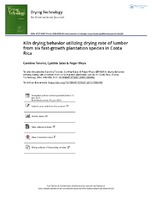Kiln drying behavior utilizing drying rate of lumber from six fast-growth plantation species in Costa Rica

Date
2016Author
Moya-Roque, Róger
Tenorio-Monge, Carolina
Salas-Garita, Cynthia
Metadata
Show full item recordAbstract
The objective was to study the effect of the drying time and moisture content variations on the drying rate during kiln drying. The moisture content is a good predictor of the variation in drying rate; to determine the drying rate, the model DR =a * t + b (where DR is the drying rate, t is the drying time, and a and b are constants) was used. Cordia alliodora, Dipterix panamensis, Hieronyma alchorneoides, and Vochysia ferruginea show a unique tendency, whereas Enterololium cyclocarpum and Samanea saman showed two tendencies. Drying rate in relation to time showed that it is possible to define the various stages during drying and the inflexion points in time where a change in the drying rate occurs. Two types of tendencies are shown in the drying rate vs. time relation in C. alliodora, E. cyclocarpum, and S. saman, whereas three tendencies appear in D. panamensis, H. alchorneoides, V. ferruginea. C. alliodora, E. cyclocarpum, and S. saman presented only one inflexion in the drying rate, which can be maintained at an average of 24.5, 11.64, and 7.83%/day, respectively, for those species. On the other hand, D. panamensis, H. alchorneoides, and V. ferruginea showed two inflexions.
Description
Artículo científico
Source
Drying TechnologyShare
Metrics
Collections
- Artículos [37]

